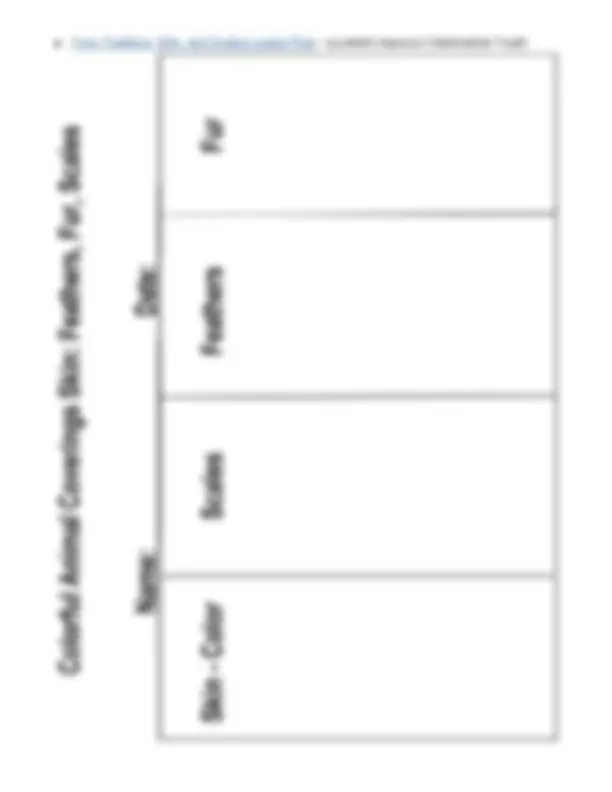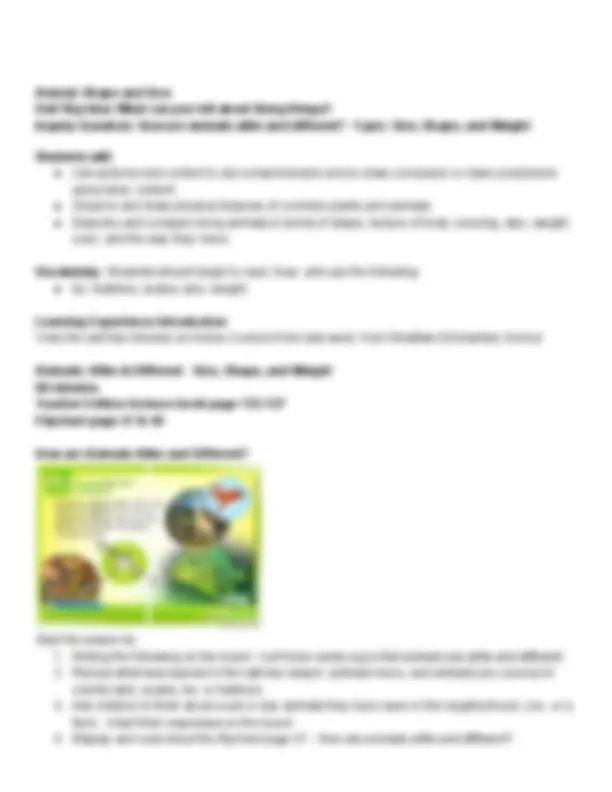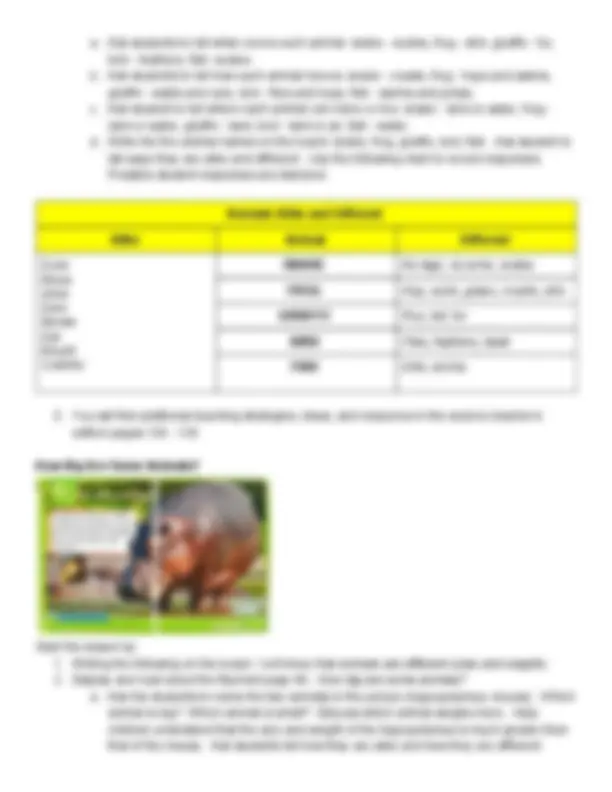





Study with the several resources on Docsity

Earn points by helping other students or get them with a premium plan


Prepare for your exams
Study with the several resources on Docsity

Earn points to download
Earn points by helping other students or get them with a premium plan
Community
Ask the community for help and clear up your study doubts
Discover the best universities in your country according to Docsity users
Free resources
Download our free guides on studying techniques, anxiety management strategies, and thesis advice from Docsity tutors
A detailed lesson plan for teaching kindergarten students about animal coverings and size. The plan includes video lessons, activities, and worksheets to help students compare and contrast how animals are covered and identify their physical features. The unit's big idea is that plants and animals are living things that grow and develop.
Typology: Study notes
1 / 7

This page cannot be seen from the preview
Don't miss anything!




Rick Crosslin - Wayne Science Living Things Grade KDG U4-3 Animal Color, Cover, Size & Shape Lesson Plan U4-3 Animal Color, Cover Video Lesson U4-3 Animal Size & Shape Video Lesson
Unit Big Idea: Plants and animals are living things that grow and develop. Inquiry Question: How are animals alike and different? Topic: Animal Coverings and Color
Students will: ● Compare and contrast how animals are covered. ● Tell how some animals are alike and different by their coverings: skin, fur, feathers or scales. ● Identify the body parts that cover an animal
Vocabulary Students should begin to read, hear, and use the following: ● Covering, skin, fur, feathers, scales (wet - fish, dry - reptiles)
Learning Experience Introduction View the last few minutes on Adobe Connect from last week: Garden City Elementary
Animal Coverings and Color 60 minutes Science workbook page - none
Start the lesson by:
2. Brown Bear, Brown Bear, What Do You See? Read aloud Brown Bear, Brown Bear, What do you see? by Bill Martin Jr., to the class. When finished ask the students to list the different types of coverings and color: ○ Brown bear - fur ○ Red bird - feathers ○ Green frog - skin ○ Goldfish - scales ○ Black sheep - fur ○ Yellow duck - feathers ○ Blue horse - fur ○ Purple cat -fur ○ White dog -fur ○ Teacher - skin
Use the Colorful Animal Coverings Skin: Feathers, Fur, Scales student worksheet for students to take notes and make drawings of the different animal coverings they discover.
4. Animal Toss Game This is a game to reinforce animal coverings. Start with having your student form a circle on the floor or meeting rug. Hold up one animal. A stuffed brown bear would be a perfect start, but is not necessary. Tell students in this game you take turns naming an animal covering type (fur, feather, or scale) or color. Say aloud, “Bear, bear, what do you see?” Ask students to raise their hand. Call on one student and give them the stuffed animal. After they respond (fur or brown) ask the student to repeat, “Bear, bear, what do you see?”. Pick another student to respond to fur or brown. Once both have been identified move to the next animal and the next two students. You can also do this with images on the computer or drawings. 5. Animal Bulletin Board Reinforce this week’s science lesson by creating a classroom bulletin board in the same manner as the student worksheet. Provide student drawings, pictures, and images of various animals. Ask students to sort them and place them on the board.
Resources ● Colorful Animal Coverings Skin: Feathers, Fur, Scales - student worksheet ● Brown Bear, Brown Bear, What do you see? by Bill Martin Jr., illustrated by Eric Carle ● Animal Toss Game materials ○ Soft stuffed animals - Beanie Babies or other - six or more ● Animal Images: ○ Scales - fish and reptiles ○ Fur - mammals various colors ○ Feather - birds various colors ○ Skin - humans, frogs, toads - amphibians
Animal: Shape and Size Unit Big Idea: What can you tell about living things? Inquiry Question: How are animals alike and different? Topic: Size, Shape, and Weight
Students will: ● Use pictures and context to aid comprehension and to draw conclusion or make predictions about story content. ● Observe and draw physical features of common plants and animals. ● Describe and compare living animals in terms of shape, texture of body covering, size, weight, color, and the way they move.
Vocabulary Students should begin to read, hear, and use the following: ● fur, feathers, scales, size, weight
Learning Experience Introduction View the last few minutes on Adobe Connect from last week: from Westlake Elementary School
Animals: Alike & Different - Size, Shape, and Weight 60 minutes Teacher Edition Science book page 133- Flipchart page 47 & 48
How are Animals Alike and Different?
Start the lesson by:
a. Ask students to tell what covers each animal: snake - scales, frog - skin, giraffe - fur, bird - feathers, fish -scales. b. Ask students to tell how each animal moves: snake - crawls, frog - hops and swims, giraffe - walks and runs, bird - flies and hops, fish - swims and jumps. c. Ask student to tell where each animal can move or live: snake - land or water, frog - land or water, giraffe - land, bird - land or air, fish - water. d. Write the five animal names on the board: snake, frog, giraffe, bird, fish. Ask student to list ways they are alike and different. Use the following chart to record responses. Possible student responses are italicized.
Animals Alike and Different
Alike Animal Different
Eyes Move Alive Ears Bones Eat Mouth Colorful
SNAKE No legs, no arms, scales
FROG Hop, swim, green, croaks, skin
GIRAFFE Run, tall, fur
BIRD Flies, feathers, beak
FISH Gills, swims
How Big Are Some Animals?
Start the lesson by:
Name: ___________________________________ Date: _____________
Live Animals I Observed
Alike Animal Different - Special